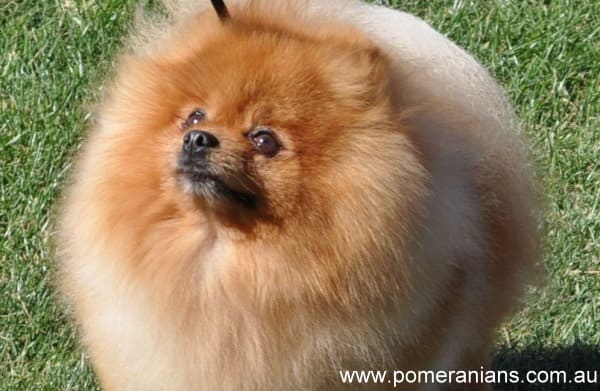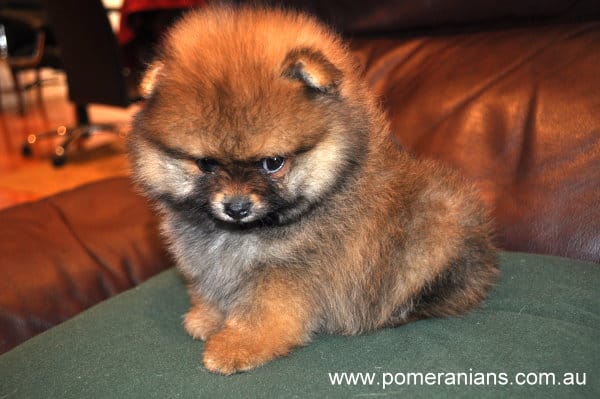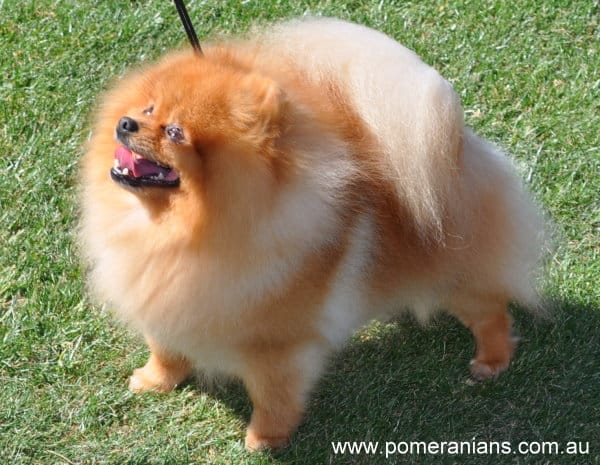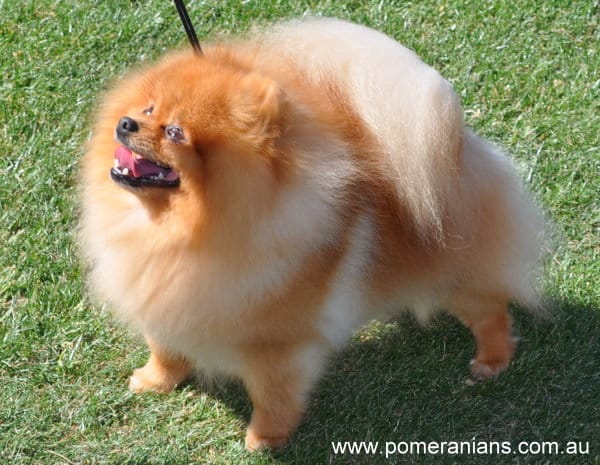Last Updated on November 24, 2021 by Denise Leo

Interesting Facts About Pomeranian Puppies – Important Pomeranian facts for all Pom dog lovers:
How Big Do Pomeranians Get?
Thanks to more than a century of selective breeding, the Pom is now a small dog.
How Much Should a Pomeranian Weigh?
How much do Pomeranians weigh? This dog breed is different from most, as the female is required to be a little bigger than the male counterpart.
The Pomeranian ideally weighs: Females should weigh 2-2.5 kgs and males should weigh 1.8 – 2 kgs.
A full-size Show Pomeranian weighs 2-3 kgs. This is the average weight of a Pomeranian show dog. This is a small Pomeranian dog. Pet Poms often weigh more, but officially there are no different Pomeranian sizes.
How Tall is a Pomeranian Dog?
In Australia, the Pomeranian breed standard does not mention height, only weight.
Different Types of Pomeranians?
Types of Pomeranians? How can you tell the differences between the Standard Pomeranian, Teddy Bear Pomeranian, Miniature Pomeranian, Mini Pomeranian, Toy, and Teacup Pomeranian?
There is only one Pomeranian and they’re all the same breed. There are no different types of Pomeranians.
Click here to find out the facts about teacup Pomeranians.
Pomeranian Personality?
Pomeranians are incredibly intelligent and enjoy learning. They are outgoing, loving, playful, loyal, energetic, and lively. Pomeranians are usually gregarious. Pomeranian traits include loyalty, love being with people and they make great companions. They’ll often pick their favourite family member but will still love the whole family.
Can a Pom Dog Live In A City Apartment?
As a small dog, Pomeranians (along with other small dog breeds as well as cats) thrive in small apartments As a medium energy dog, short walks will soon tire them out. If you have a small yard, they’ll enjoy that as well.
At What Age Does a Pomeranian Stop Growing?
All dogs are classed as puppies until 12 months of age. A Pom dog is not fully grown until 12 months. A 1-year-old Pomeranian is classed as a Pomeranian adult.

How Long Do Pomeranians Live?
How long does a Pomeranian live? He’s a healthy breed of dog and the life expectancy of Pomeranians is 12-16 years of age, provided that he’s cared for properly.
Do Pomeranians Bark A Lot?
Poms are individuals. Some will bark a lot and others will be fairly quiet but may still bark if the doorbell rings or they hear a noise. Many Poms are good security dogs because they’ll bark if they see something exciting is happening.
Your Pom will sleep if the household is quiet and will stay asleep unless there’s a visual or auditory disturbance. He generally won’t bark enough to annoy your neighbours when you’re away from home.
Do Poms Nip?
The Pom has earned a reputation as a nippy dog. This is generally a training problem. If he’s spoiled, he may snap if another person gets between him and his master. Owners shouldn’t let it happen. If this does describe your dog’s behaviour, talk to a trainer as a matter of priority.
Social Poms are generally pleased to meet strangers unless they’re threatened or cornered. Some Pom dogs are quite submissive and, if they’re scared, nipping is a reaction to that fear. Training and better social skills should help the Pom grow out of that phase.
How Well Do Pomeranians Cope With Small Children Being Around?
Owing to the breed’s diminutive size and high energy levels, the Pomeranian is not recommended for families who have small children. It’s usually not wise to get a Pom if you have young children. The exception to this is if you already have a pom or have had one in the past and understand everything it takes to care for him. Young children must NEVER be allowed near a Pom unless an adult is supervising and children shouldn’t be allowed to annoy the Pom.
If your Pom has had a bad experience with a small child in the past, he’s more likely to bite. This isn’t good for anybody. Small children must be careful if they’re allowed to play with the Pom as it’s easy to accidentally drop him and cause a leg to be broken, as well as many other problems.
If you already owned a Pom before you get small children, the best thing is to keep them separated completely unless they’re strictly supervised.
While Poms are fantastic pets, children should be 8 years or older before playing with the Pom. Safety should be the number one priority in this situation.
How To Potty Train a Pomeranian?
The Pom is known as one of the most stubborn of all dog breeds when it comes to house training them. Crate training is the recommended solution, especially if he’s quite young, is a new addition to your household, or if can’t fully supervise him as he wanders around because everything is new and strange for him.
Indoor Grass Potty Mats work well for Pomeranians. If your Pom doesn’t have the run of the house and can potty without you scolding him, the training will be accomplished much faster. Poms are usually clean and, once they reach six months of age where they can hold their bladder for up to six hours, you should still let them out for a potty break regularly to ensure it’s done outside.
Your Pom’s main times where he’s most likely to need to potty are: after waking up, before bed, after he has eaten and whenever he has been in his crate for any lengthy-time period. Take him outside immediately after these events and you’ll avoid most accidents in the home.
Use a good cleanser to get rid of doggy messes straight away.. He can smell where prior accidents occurred and are drawn to that same spot. Cleaning must eliminate those spots. Spaying and neutering reduce the accidents as it decreases the pom’s need to mark his territory.
Pomeranian Grooming. How Much Care Does a Pom’s Coat Need?
Although a Pomeranian’s coat will not need as much care as some of the other coated dog breeds, it is still essential to groom him a minimum of 2 – 3 times each week.
If you brush him regularly, his full coat is easy to look after. He needs weekly, thorough brushing with a hard pin brush (it has metal pins on the end). A good example of a brush to use on your Pom is the following Fromzerotohero Pet Dog Hair Remover Brush Pet Dog Bathing Scalp Cat Dog Beauty Wooden Massage Comb A Slicker brush is ideal for Pomeranians Fromzerotohero Pet Dog Hair Remover Brush White Air Bag Handle Puppy Comb Pet Pet Teddy Golden Hair VIP Pet Beauty Comb
Brush him deeply, down to his flesh, and ensure you pay special attention to his rear, behind his ears, and under his armpits, as those are the spots where hair mats easily. A good anti-static comb is also helpful to remove dead hair. Fromzerotohero Pet Dog Hair Remover Brush Dog Open Knot Hair Removal Comb to Dead Hair Anti-Static Stainless Steel Dog Comb Long Teeth Open Solution (L, Black).
A monthly bath is also recommended and when required as some days he’ll get dirtier than other days. If your Pom spends a lot of time outside the home, it’s recommended that he needs more frequent cleaning as he loves getting dirty, muddy, and smelly at times.
Best Shampoo for Pomeranian Dogs
The best shampoo for Pomeranians is an Oatmeal Shampoo, which is great for keeping Pom dog coats looking their best. Dog Shampoo Oatmeal and Aloe Vera Aloveen 250ml Dermacare. Another good shampoo for Pomeranians is an Oatmeal and Tea Tree Shampoo Dog Shampoo Oatmeal and Aloe Vera Aloveen 250ml Dermacare
Refer to the Pomeranian Grooming Guide for complete information on Grooming your Pomeranian.
Cut your Pom’s nails monthly and so cutting nails prevents them from making noises on tiled floors.
A great type of nail clipper for Pomeranians is the following:
Tradico®Stainless Steel Nail Clipper File for pet Dogs red Black Small Size N3 and PETCUTE Professional Cat Nail Clippers For Small Medium Dogs, Cats, Rabbits. Cat Dog Nail Clippers Scissors-Super Sharp Blades and Comfortable Rubber Slip Free Handles
If you can’t handle regularly grooming your Pomeranian, you should take him to a reputable grooming salon. It’s not wise to shave your Pom down because it may never grow back. A groomer often has no option if his hair is badly matted so it’s vital that you take your pet to the groomer before matting can grow. It’s also a good idea to brush him each week to ensure the good condition of his coat.
Details on trimming a Pomeranian’s toenails.
Pomeranian Exercise Requirements
Because he’s small, he doesn’t need too much exercise. However, short walks or a run around the garden are necessary activities each day to keep him healthy and fit.
Do Pomeranians Shed a Lot?
Do Pomeranians Shed? How much do Pomeranians shed? Generally, a Pom doesn’t shed much coat or fur. However, twice a year there’s a huge shedding period when the soft undercoat becomes looser. If you can see that your Pomeranian is shedding, you need to brush him urgently or the hair can quickly get matted and cause problems.
Is the Pomeranian Hypoallergenic?
There’s no such thing as a hypoallergenic dog. Some will shed more often than others but the majority of allergies are because of dandruff.
Pomeranian Teeth Problems. How to Clean Pomeranian Teeth?
Pomeranian baby teeth are sometimes retained and may require extraction by your Vet. Small dogs are more likely to lose their teeth than lots of bigger dogs. It’s part of your vet’s duties to ensure your Pom’s teeth are strong and healthy and to fix any problems.
You also must check for tartar which can cause tooth decay and Pomeranian tooth loss quite early in his life. To avoid problems, you must either learn how to clean Pomeranian teeth regularly or take him to your vet to get his teeth cleaned. Anaesthetic is used so the vet can clean the teeth of any dog breed.
To prevent this, you can brush their teeth regularly, and/or take them in for regular dental cleanings. Dental cleanings require anesthesia and are performed at your vet’s office. It can be expensive and there’s always a risk of other problems happening when an anesthetic is used.
So regular brushing may be a good alternative. I recommend the following for Pomeranian dental hygiene Doggie Toothpaste Nylabone Advanced Oral Care Natural Toothpaste | Peanut Butter Flavor 2.5 ounce or Zehui Pets Dog Toothbrush/Cat Toothbrush Three-sided Toothbrush Pet Dental Care Toothbrush Massage Brush Cleaning Supplies
Common Pomeranian Health Problems
Pomeranian Dog Health Problems Explained. Health problems in Pomeranians:
As with any breed of dog, Pomeranians can face various health issues, both non-genetic and genetic in origin. Congenital (present when they’re born but not always hereditary) issues include heart problems, tracheal collapse, epilepsy, patellar luxation, hypothyroidism, Legg-Calve-Perthes disease (problems with the hip’s femoral head), and alopecia X (nicknamed Black Skin Disease).
My Pomeranian is Limping- Patellar luxation
The most common Pomeranian health issue is patellar luxation. This is another phrase for a “bad knee.” It can vary in intensity and severity. The mildest form is barely noticeable by your dog and he can still be used for breeding. The worst case is when surgery is needed. Pomeranian knee problems are not rare and if you see your dog carrying his leg up or skipping, talk to your vet. Make sure your Pom is kept fit and trim and don’t let young puppies jump down from a bed, furniture, or steps.
Pomeranian Coat Loss Alopecia X Black Skin Disease
This is the second most common Pomeranian problem and happens when your Pom loses hair without you knowing why. Current studies are investigating its hereditary possibilities and the cause, but no definitive answer has been proven so far.
Pom Puppy Hypoglycaemia
Your Pom puppy may face hypoglycemia (low blood sugar levels). This occurs when he uses more energy than he can take in via his food. If he plays a lot and doesn’t stop eating when given food, or if he has diarrhea or a stomach upset, his sugars can drop down quite low.
If you have a puppy under six months of age or under 1.5 kgs in weight, make sure he eats regular nutritious meals and monitor him for signs of diarrhoea. If he has diarrhoea and/or won’t eat, take him straight to the vet for medical attention. Indicators of hypoglycaemia include: lack of coordination, drooling, seizures or losing consciousness. Your puppy will seem dazed and will stumble around before he collapses.

Hypothyroidism In Pomeranians
Hair loss can be due to hypothyroidism and this ailment is often mistaken for Alopecia X. If your vet does suspect hypothyroidism, he’ll first check the thyroid levels. If he prescribes a drug to treat this condition, symptoms should slowly vanish once your pet’s thyroid levels return to normal. If this doesn’t happen, hair loss may not be caused by the thyroid.
Pomeranian Breathing Problems-Pomeranian Trachea Problems
Pomeranian breathing issues usually involve the trachea. Is your Pomeranian wheezing gagging? This is a windpipe problem. If it collapses, your dog will have trouble breathing and will also have a persistent cough.
Pomeranian Heart Disease
Pomeranian heart problems may vary. Some issues are present when the puppy is born, as a Pomeranian heart murmur. If he has a heart murmur or he may have trouble breathing properly. Your Vet should give the puppy a full examination 8-12 weeks after he’s born and then congenital ailments should be noticed and your Vet can tell you how to move forward. Other medical problems may appear as the puppy grows up.
Pomeranian Seizures – Epilepsy in Pomeranians
Epilepsy is described as having seizures where there’s no known cause. They can vary in intensity from very mild “tic-like” symptoms to full-blown grand mal episodes that can be frightening to watch. If you see anything unusual in your pet or you suspect he’s having seizures, ring your vet urgently as it may be epilepsy or a different problem.
Legg-Calve-Perthes disease (LCP)
This is a medical condition where there’s a degeneration of the hip’s femoral head. It may be due to genes or because of an injury. If it’s inherited, it will mostly be noticed prior to the puppy turning one year old as he’ll generally walk with a limp. Fortunately, it can be diagnosed via x-ray and surgical intervention usually results in a full recovery. If your pet does limp, get your vet to examine his patellas and take x-rays in case either LCP or hip dysplasia may be causing it. Most Pomeranian hip problems are Legg-Calve-Perthes disease.
Pomeranian Eye Problems
Poms don’t commonly suffer from eye problems but, as with all medical problems, eye issues can happen, particularly in older dogs.
Note: This medical information is far from comprehensive and isn’t a definitive resource. It’s just a guide to help potential new Pomeranian buyers. If you think your Pom has any problems, consult your vet as a matter of urgency.
What Are The Pomeranian Puppy Uglies?
The coat of a Pom puppy generally changes into an adult coat over time. It’s this transitional period that’s described as the “puppy uglies.”
The Pomeranian uglies generally start at around three months of age and have fully changed by the time he gets to about nine months old and his coat is that of an adult.
The colour will also become darker or, if he’s a sable, the coat may lighten in colour. Some breeders believe that if a Pomeranian puppy doesn’t go through the “puppy uglies,” he may have future problems with coat loss once he becomes an adult.
Pomeranian Average Price?
Do you want to know how much is a Pomeranian puppy and how much money is a Pomeranian? This is a hard question to answer, as most breeder’s prices of Pomeranian puppies differ, backyard breeders are cheaper and pet shop puppies are the most expensive.
Go to the Pomeranian Headquarters Website for a complete explanation of what Pomeranians cost.
For complete and detailed Pomeranian information: Download the Pomeranian Book by Pomeranian Breed Authority Denise Leo.
This article is not to be reproduced in any form without the written consent of the author.
Copyright Pomeranians Australia ©. All Rights Reserved.
References and Further Reading:
[1] Leo, Denise. “Pomeranian Health Issues.” Pomeranian Headquarters. www.pomeranian.org/pomeranian-dog-health-issues-explained/.
[2] Denise Leo “The Pomeranian Grooming Guide”.
[3] Denise Leo “The Pomeranian Handbook”.
[4] Denise Leo “Training Your Pomeranian”.
Learn Everything About Pomeranians in The Pomeranian Handbook
( Printed and shipped in Australia).


